Town hall planning to return favour
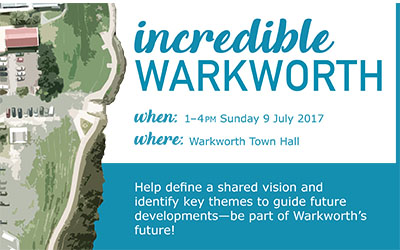
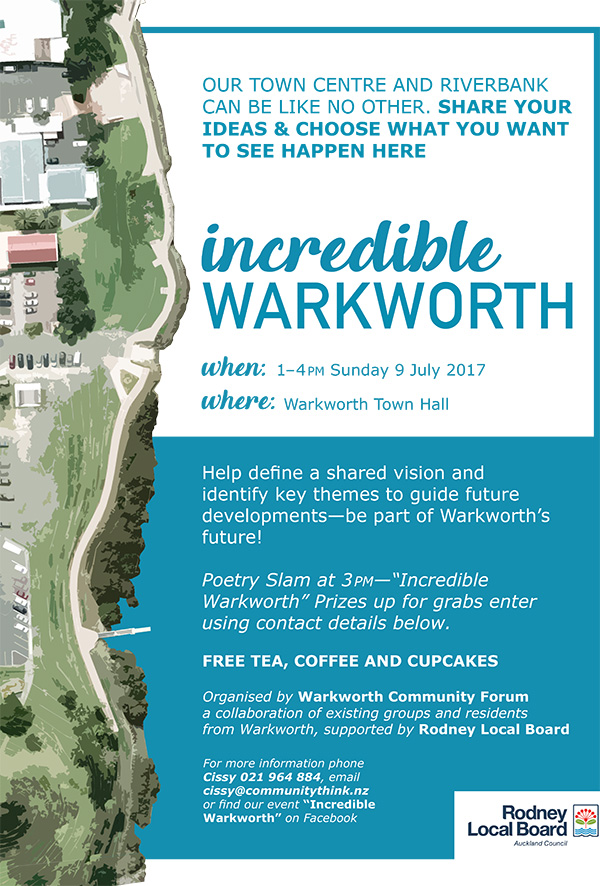
Incredible Timing: After being out of commission for six years, the revival of the Warkworth Town Hall is timed perfectly for it to return the restoration favours it has received, by being put to work ensuring the town’s future is incredible, and not same-old-same-old. flier Warkworth community forum
By 2019, many of the decisions about the new Warkworth could be being made in its old town hall.
The Local Government Commission is currently considering reorganisation options for the Auckland region, including an alternative proposal made by Mahurangi Action and, 38 other submissions on the subject.
The commission has received a range of entreaties, from the radical restructuring of the entire region, to a turn-the-clock-back-60-years isolationist, county council for cowboy developers. A second radical restructuring in quick succession would be to duplicate the last seven years of disruption and fuel further community–council alienation. Nor would an under-resourced old-style district council protect the Mahurangi landscape from being ritually scrapped bare for three-bedroom breeding boxes. Neither extreme will be recommended by the commission.
Two, more moderate, proposals are being considered. They involve breaking the geographically unwieldy Rodney Local Board area into two. The option that quickly received much support in Kumeū–Helensville calls for the current Rodney Ward to be split in two, and for two councillors to represent the area, rather than one, as at present. But the only way that this could be done without violating the one-person-one-vote foundation of democracy is if the each of the two ‘Rodney’ representatives had half a vote each, or that the number of Auckland Council councillors was doubled to 40.
The Mahurangi Action proposal, in contrast, is the epitome of practicability. Rather than alter the ward arrangement, only the local board structure needs to change, with two boards in place of the existing one. As well as the obvious advantage of having a board to focus on each area, rather than all local board members being obliged to all travel out of their local board areas to meet, in Ōrewa, one board would meet in the Kumeū area and the other in Warkworth.
As luck would have itluck had, of course, had little to do with it; dedication and determination, a lot, the new northern local board already has the ultimate venue in which to meet: the newly restored Warkworth Town Hall; the home of the Warkworth Town Board from 1911, two years after the board’s inception. Now, rather than wait for the Local Government Commission process to laboriously run its course, and for the 12 October 2019 local-body elections to vote in the inaugural local board members, Mahurangi Action has initiated the concept of regular Warkworth Town Hall Talks, to encourage the community to think of the ambitiously Art Deco-mongrelised building as the place where the future of the town, and the balance of the district under the gentle dominion of Mount Tamahunga, is discussed and decided.
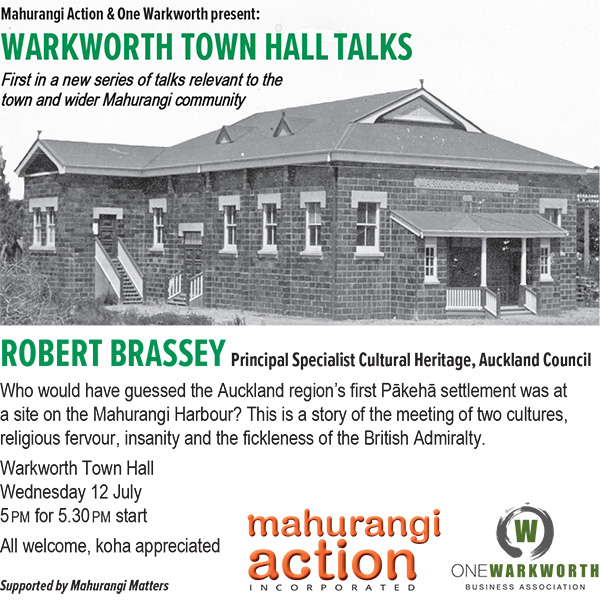
Wild Mahurangi West Past: Serving to perfectly anchor discussion about Warkworth’s future, Robert Brassey will bring to life the incredible story of the Auckland region’s first Pākehā settlement, established in 1832 in Brownes Bay, Mahurangi Harbour. flier Mahurangi Matters
It is appropriate, but not planned, that the first Warkworth Town Hall Talk is not about Warkworth; it is about Browne, and not about Brown. The town’s founder, John Anderson Brown purchased the land involved in 1853, but 21 years earlier, Gordon Davies Browne established the first Pākehā settlement not only in the Mahurangi, but in the entire Auckland region. And although it only endured for four years, those years were action-packed and pistol-toting, and it was said by one contemporary that Browne was:
…in a great measure entitled to the credit of having established the timber trade of New Zealand.
While this may have been an exaggeration, Browne literally sacrificed his sanity for his part in the trade.
Spar stations, such that established by Browne, Dacre and Kendall, as well as spars for the Admiralty, generally produced timber and built ships, but in the case of Mahurangi not the latter, although a shipbuilding era did follow, from 1849. However, that illustrious era withered once Auckland gained critical mass, drawing the enterprise to that port, just as the scow era was taking off in the late 1870s. Not so the work of deforestation and grazing, which, by World War II had eliminated 80% of the indigenous cover, and precipitated the loss, at the very least, of seven million tonnes of topsoil, if the contemporary average rate of nearly 46 000 tonnes per year is any indication. The actual loss could be closer to 10 million tonnes, given that the vast bulk of the disruption must have occurred during the active phases of deforestation.
Most of the sediment accretion has occurred in the upper estuary and tidal shallows, and in the tidal reach to Warkworth, in places to a depth of three metres or more. It is this sediment that is the target of the Mahurangi River Restoration Trust’s dredging programme, which now has Auckland Council’s formal approval.
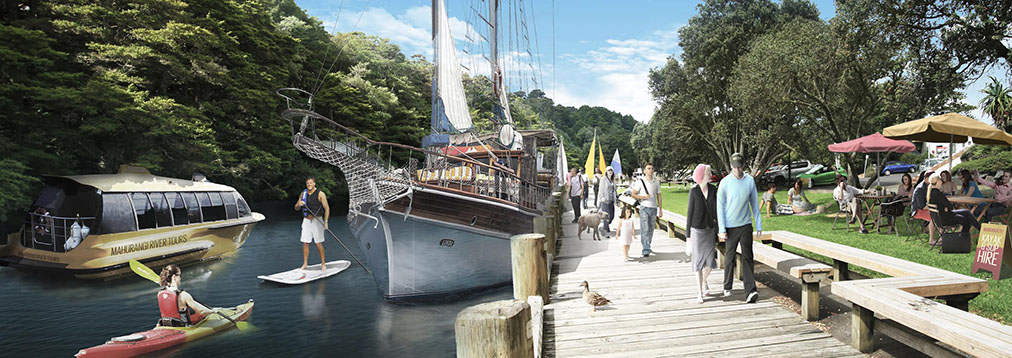
Incredible Tidehead Backdrop for Incredible New Town: The Mahurangi wasn’t consulted before Auckland Council decided that Warkworth was to be a satellite growth centre, but the community is determined that the best possible use of the town’s natural assets be made in the planning for 20 000 more people. The river richly deserves to be spine of a walkable and swimmable linear park that connects and binds the new with the refurbished—the subject of the sparkling Warkworth Town Hall event on Sunday 9 July. visualisation Jill Guillemin | White Landscape and Urbanism | Mahurangi Action
Meanwhile, on the outskirts of Warkworth, Portland cement manufacture took over as the area’s main employment, from 1885 through to the late 1910s—about the time William Thompson Rauparaha Cook took over as the sixth owner–editor in the first 16 years of what now survives in Fairfax ownership as the Rodney Times. Cook’s grandson founded the town’s then biggest industry since the cement works, printing, and although that was relatively short-lived, the print halls provided prefect premises for Core Builders Composites, the builders of most of today’s America’s Cup boats, daggerboard-foils and wings.
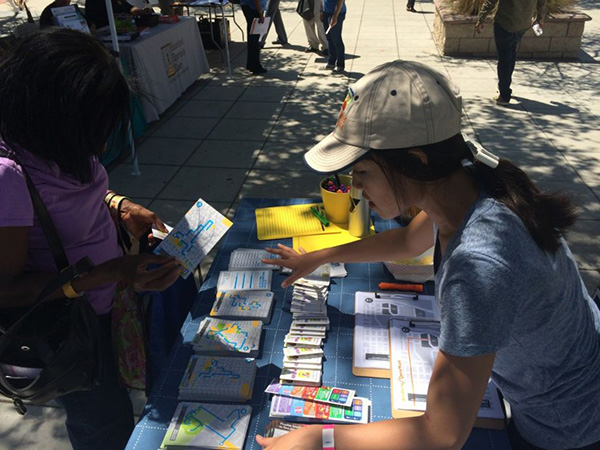
Town Hall Planning: Without recourse to its citizens, the new Auckland Council promptly decided that Warkworth’s fate was to be a satellite growth centre. Now, its moral guardians—those who know it best, the citizens of Mahurangi—are asserting their right to help shape the future of their beloved tidehead town. An afternoon drop-in workshop will be held in the Warkworth Town Hall on Sunday 9 July to seek further feedback on existing plans and concepts, and hopefully also receive fresh ideas. Here, citizens of Long Beach, California, participate in the drafting of that area’s first pedestrian master plan. image City Fabrick
But this world-class high-tech operation is about to be eclipsed, by sheer volume, by Warkworth’s biggest industry to date: the building of what will essentially be a new town, of 20 000 people. Now the Warkworth Town Hall can play a central role in restoring the community’s right to participate in shaping its future—particularly, how the town’s explosive growth is planned for. Left to individual developers, all indications are that Warkworth will suffer same-old-same-old, car-centric suburbanisation. While it was appropriate for suburbs to be designed around the motorcar 62 years ago, it is now universally and locally accepted that urban design must prioritise walkability—aside from the existential need to preserve a survivable climate, it is the proven way to walk back the global obesity epidemic. And anthropogenic global warming is an existential crisis, and the defining issue not just of the 21st century, but for Homo sapiens sapiens period.
The location of settlements established by Browne and Brown were both dictated by the need to be beside the Mahurangi. In Browne’s case, his settlement was at the limit of navigability by ships, such as the Bolina that landed his party there in 1832, or navigability by shoal-draft vessels, when a ship’s boat deposited Brown at the tidehead, at what was to become Warkworth, some claimed as early as 1843The Rock and the Sky, Harrold Mabbett, 1977. With resource consent secured by the Mahurangi River Restoration Trust to begin dredging the Mahurangi River to improve the prospects for the town basin, the river is set to again become pivotal for the town. But it must also be the element that seamlessly connects the new town to the old, via a linear park prioritising walking and cycling, and, through eco-sensitive design, that improves the water quality to the point of swimability:
Swimmable and walkable Warkworth.
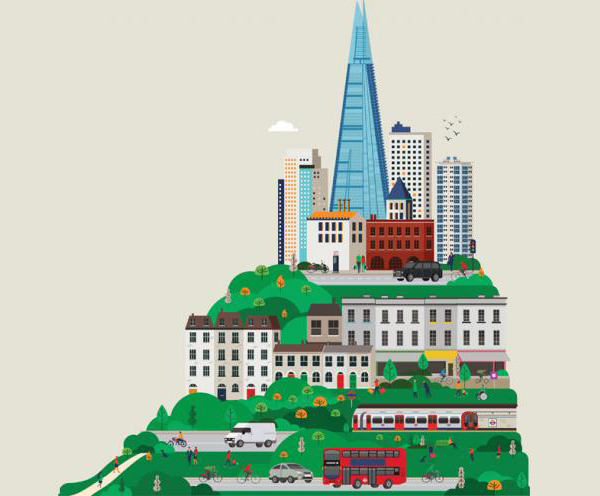
London in the Lead: Mayor of London Sadiq Khan is not so Left as to frighten TPP-voting neoliberal Auckland mayor Phil Goff, so there is a chance at least that Makaurau could be a fast follower of Khan’s refreshingly straightforward strategy to reclaim the streets for the many—a win-win-win for transport, climate and public health. And where new streets are planned, such as for Warkworth’s vast new greenfields development, there can be no excuse for failing to create healthy streets and street networks. graphic Greater London Authority
On Sunday 9 July, the Warkworth Town Hall will host an afternoon’s exploration of ideas for the Mahurangi riverside and Warkworth town centre. This is a Rodney Local Board initiated, joint board–community effort to determine the community’s priorities for, mostly river-oriented, projects between the Mahurangi College and the Wilson Cement Works. Known projects will be on display, but fresh ideas and concepts will be keenly sought—nothing will be presented as a done deal, except perhaps the consented dredging programme and a linear playground designed with and for teens, by the area’s Lions clubs and local professionals. One of the concepts that will be exposed for discussion will be that of the Mahurangi River as the spine of a broad open-space corridor connecting old and new, providing paths suitable for walking and cycling but perhaps also for e-bikes—make that probably, given that the streets of old Warkworth were laid out with little consideration of gravity. The broad green linear park would also provide opportunity for stormwater to be naturally treated, to increase river swimability.
One of the aims of the consultation is to ensure that the structure plan process tipped to begin next year is informed by the community’s aspirations for the new town. But a structure plan, under current rules, only addresses land currently zoned as future urban; the existing town would be acknowledged, but not included in the planning. For the future direction of the existing towns, Auckland Council conducts a centre plan process, and centre plans have been produced for Milford, Silverdale, and Takapuna. Given greater Warkworth’s clear and present need for holistic planning, it is imperative that the two processes be run in tandem.
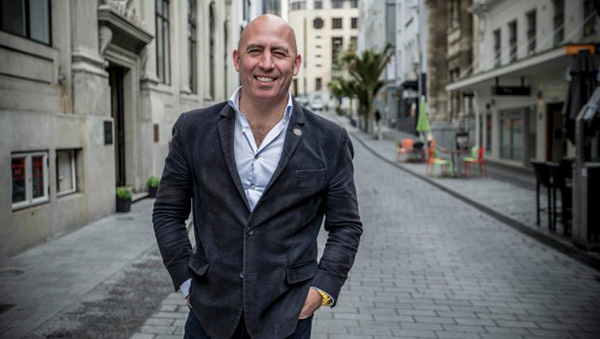
Sexy, Current and Abuzz: London-born Ludo Campbell-Reid might well have been describing the prospects for the 2019 or 2021 Waitematā America’s Cup, but in fact was making the point that no one goes to visit boring cities. And in saying that Auckland ‘is killing itself because it’s so automotive-dependent’, will apply to Warkworth if it allowed to develop in the same-old-same-old car-centric manner as elsewhere in Aotearoa. If Warkworth’s parking problem is perceived as chronic now, adding four or five times the number of cars, whilst preserving driving as the only ‘safe’ and convenient way to move about the town, will leave it gridlocked morning till night. image Jason Dorday | Stuff
In stark contrast to the first Pākehā settlement in the Auckland region, established in the aftermath of the musket wars, the second Warkworth Town Hall Talk—potentially, in August—will be on the possibilities presented by the fastest-growing town in the Auckland region. The speaker is to be urbanist Ludo ‘Imagine If…’ Campbell-Reid, design champion and general manager of the Auckland Design Office at Auckland Council.
For years, the fate of the Warkworth Town Hall hung in the balance, with many townsfolk, at best, ambivalent about its value. But restored, and good for another 106 years, the town hall can now return the favour, by hosting a credible community discussion of the town’s future.
And it is imperative that Warkworth’s new biggest industry, the accommodating of 20 000 more people, is incredibly bold—up there with its world-beating boatbuilding.
